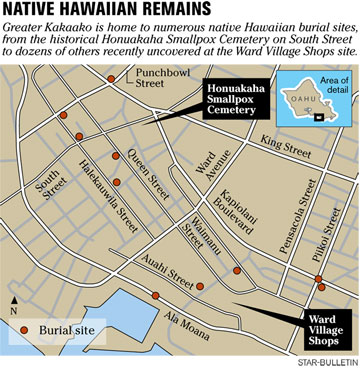 DENNIS ODA / DODA@STARBULLETIN.COMNative Hawaiian burials are scattered throughout greater Kakaako, according to archeological reports written over the last 20 years. Above, Lurline Naone-Salvador, a cultural consultant, overlooked the construction site of the Ward Village Shops in Kakaako. She said she isn't surprised that parts of Kakaako are burial sites for hundreds of remains. CLICK FOR LARGE |
|
Kakaako rich with Hawaiian history
Hundreds of iwi have been uncovered in the area, which once was a thriving community
Hawaiian cultural consultant Lurline Naone-Salvador is not surprised that parts of Kakaako are burial sites for hundreds of native Hawaiian remains.
Having served two terms on the Oahu Island Burial Council as a Kamehameha Schools representative, she's had plenty of experience dealing with the sensitivity of burial issues within a development.
She credits her father, Herbert Naalohaelua Naone Sr., for much of her cultural knowledge.
With her consulting company, Kahili'ula Associates, Naone-Salvador researches and recommends appropriate Hawaiian names to developers for their projects.
Among those she has named are: Keola La'i, Alexander & Baldwin's newest residential high-rise on Queen Street; and Nanea, the Charles Schwab golf course on the Big Island. She's also done extensive research on the Kakaako area.
"Kakaako was once a thriving community, with agricultural terraces, residences of ali'i (royalty) and docks for foreign ships," said Naone-Salvador.
Kamehameha I had a residence in Kakaako, she said, along with his family, and personal kahuna, Hewahewa, who was his chief adviser.
 DENNIS ODA / DODA@STARBULLETIN.COMAbove, tents at the construction area of the Ward Village Shops in Kakaako covered the site of uncovered remains to protect them from sunlight. CLICK FOR LARGE |
|
Kakaako, also known as Kewalo, according to archaeological reports, was a place of recreation -- particularly around the shoreline. The waters were used for cleansing, fishing, canoe landings and religious practices.
Naone-Salvador, in her research, found that selected individuals were drowned in the waters of Kewalo and then taken to Punchbowl and offered as sacrifices.
Sailors arriving on a foreign ship in 1853 brought smallpox, which spread and inflicted thousands of Hawaiians. Because of the large numbers, many were buried in shallow graves, said Naone-Salvador.
Now, Kakaako also has become a hotbed of development, and home to several shiny, high-rise residential towers and retail centers.
The unearthing of iwi, or native Hawaiian remains, has led to controversy at one particular site.
At least two archaeologists have differing estimates of the number of iwi at the six-acre Ward Village Shops site, where General Growth Properties plans a Whole Foods Market, parking garage, retail shops and 17-story rental apartment.
The count so far by Cultural Surveys Hawaii, hired by General Growth, is at more than 50 sets of iwi, with more updates to come as it continues to monitor the site.
Thomas Dye, president of the Society for Hawaiian Archaeology, meanwhile, stands by his professional estimate of as many as 335 remains.
The state historic preservation division in June ordered General Growth to redesign its project in order to preserve the iwi in place.

STAR-BULLETIN | CLICK FOR LARGE
DOCUMENTED IWI
Thousands of iwi have been found over the past 20 years in greater Kakaako.
» Honuakaha Smallpox Cemetery, 1,000 burials (South Street and Quinn Lane)
» Honuakaha (545 Queen St.), 179-389 burials
» State Office Building (southeast corner, Punchbowl and Halekauwila streets), 6 burials
» Mother Waldron Park (Cooke and Halekauwila streets), 17 burials
» Koolani (1189 Waimanu Street), 18 burials
» Queen Street extension, 30 burials
» Ward Village Shops site, 53, to date
Source: Archaeological Inventory Survey Report for the Victoria Ward Village Shops Project, May 2006
|
|
GREATER KAKAAKO
Native Hawaiian burials are scattered throughout greater Kakaako, according to archeological reports written over the last 20 years.
Many Hawaiians used the Kewalo region for fishpond farming, salt making, wetland agriculture and human burials, according to Cultural Surveys Hawaii, which did several reports on the area.
Burials have been documented from beneath the State Office Building at Punchbowl and Halekauwila streets to Mother Waldron Park and the newest luxury condo towers fronting Ala Moana Boulevard.
The most significant archaeological find was the 1853 Honuakaha Cemetery at South Street and Quinn Lane, where more than 1,000 human burials resulting from a cholera epidemic were discovered.
Honuakaha, an affordable rental for seniors next to the historic Royal Brewery, also was the site for several hundred iwi. Mother Waldron Park is home to 17, which were discovered around the area and reinterred there.
At the site of what is now Koolani, the luxury high-rise condo by Crescent Heights, there were 18 burials, as well as a human mandible found on the site of the other luxury high-rise, the Hokua at 1288 Ala Moana Blvd.
Beneath the Queen Street extension project, past archaeological reports found up to 30 burials.
Naone-Salvador would support preserving burials in place within the development.
"Given the history of this area, they were buried there for a reason," she said. "I feel it would be disrespectful if they were removed. I believe that developers can always change their plans and be sensitive to the iwi within their projects. If these ancestors are treated with dignity and respect, the development will be pono (appropriate)."

